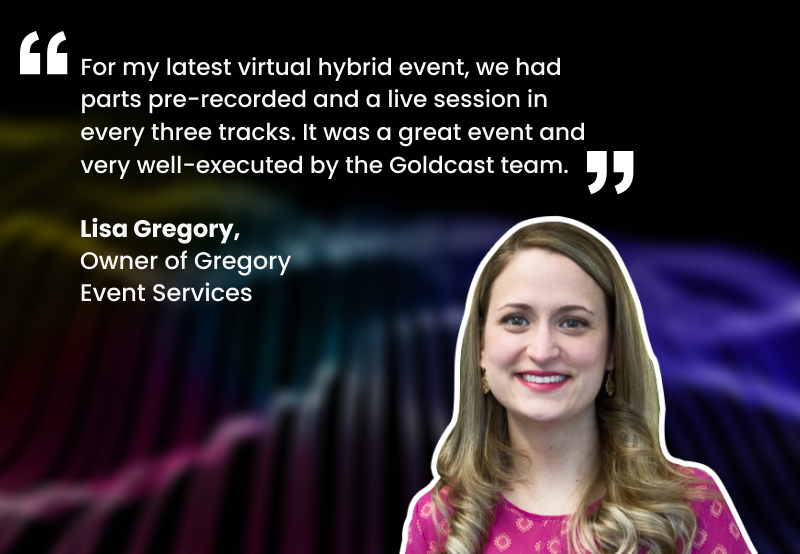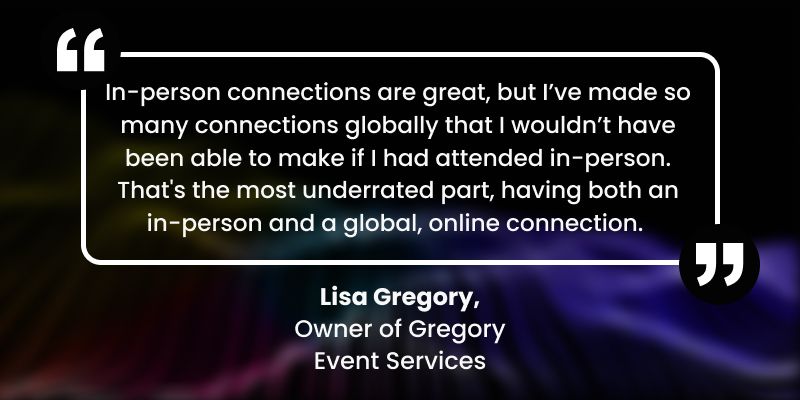Stepping into Hybrid: Lisa Gregory Shares Her Insider Tips for Winning Hybrid Events

Maximize Your Marketing ROI
Join 10,000 other marketers already getting the best tips on running engaging events that boost pipeline and create raving fans.
In an ever-changing post-pandemic landscape, there’s no doubt that the era of hybrid is upon us. And with 93% of B2B organizations seeing a positive ROI from hybrid events, it’s no wonder this new type of event format is causing such a stir.
To find out why hybrid events are the next big thing, we sat down with event marketing extraordinaire Lisa Gregory, to discover her top tips for acing the hybrid event game. And with over 20 years of experience working with world-renowned brands, she has some awesome insights to share.
Join us as we discover the hybrid models Lisa is currently loving, the industry insights driving her success, and her pandemic-proof planning that goes into every hybrid event.
So, Lisa, what were you up to before the pandemic hit?
I worked primarily with high-tech startups, managing conferences, trade shows, internal events, and marketing kickoffs, ranging from around 10 to 5,000 people.
At the start of 2020, I had just forecasted my most successful year with 29 events contracted in for January. Then Covid hit, and suddenly I was down to six.
Can you tell us more about that transition to virtual events and what surprised you most along the way?
The number of companies that just put everything on pause surprised me.
I also didn't fully anticipate how long it would take to execute virtual events. I’d think, “This will take 10 hours”, but it would end up taking 20. For live events, everything’s set up beforehand. With virtual events, there are way more small details to execute.
And the learning curve. I thought, “We'll dive in, and it will all work out,” but everything was new to everyone. This required much more communications, troubleshooting, tackling bugs, and additional requests and requirements from partners, customers, and vendors.
What did you go into virtual events expecting?
I knew I’d need to ask a lot of questions and poke holes in everything — I didn't know what I didn't know. And the platform providers didn't know what they didn't know.
So, I had to ask questions and be super inquisitive. Things like:
- What's going to go well?
- What isn't going to go well?
- What do I do if this happens?
I also knew the timelines would be shorter. In-person events require advanced approval. During Covid, we had no time — we were executing events within weeks.
Now, emerging into a post-pandemic era, we have hybrid events. We've heard a lot of different definitions — how do you define hybrid, Lisa?
Before Covid, hybrid meant running a beautiful main stage and live-streaming to an online audience, with special programming for the audience at home versus the in-person attendee.
But the new hybrid is all about running a full-blown virtual conference on a platform like Goldcast and having a venue that you're streaming from. Speakers appear both in-person and virtually
There's also the virtual hybrid model, for which Goldcast is the perfect platform — it works fantastic for us. For my latest virtual hybrid event, we had parts pre-recorded and a live session in every three tracks. It was a great event and very well-executed by the Goldcast team.
I love the sandwich model too. Have your in-person event first, then afterward host a virtual event using the in-person content and a unique virtual offering.
At solely in-person events, attendees can’t view sessions at the same time. You can post the content online, but the excitement drops. With Goldcast you can pre-record everything, edit the videos and use them at your virtual event within hours.

Sounds awesome. So what’s the most underrated hybrid event feature?
The events team — getting a strong team behind you is number one.
On the platform side, it's the connection. In-person connections are great, but I’ve made so many connections globally that I wouldn’t have been able to make if I had attended in-person. That's the most underrated part, having both an in-person and a global, online connection.

What's a reasonable budget when running a hybrid program?
Put together your in-person budget and your virtual budget. Then increase that by at least 10-25% for the extra production elements.
External consultants will require you to double your budget, as they'll be running two events simultaneously.
What percentage of goals can we reasonably expect from the digital side?
When virtual events came out, people were getting crazy engagement. Now that it’s been around longer, digital engagement is going down the more virtual you do. Hosting a few virtuals a year will hopefully mean you'll see attendance start rising again.
But with exceptional content, speakers and marketing, your event percentage will be higher and your registrations will improve.
A lot of the content going out currently feels the same. Don't be afraid to be different — do guerrilla marketing, make a splash.
Zoom fatigue is real right now, what are your thoughts on a good turnout?
Clients always ask me: “I want 3,000 registrants; what percentage will show up?”.
But there's way more to it than that.
It could range from 35%, which is not great, to 85%, which is wonderful. To fully answer that question, we’d have to dig into:
- How are you building your community?
- What have you been doing to nurture them since your last event?
It then comes down to asking yourself the right questions:
- Are we requiring non-Gmail registration emails?
- Are we recruiting only customers or both customers and prospects?
And ask your team way more questions too, like:
- What exactly are our goals?
- Who can we get there?
- Who do we want there?
When I asked for your advice on a hybrid event recently, you showed me an excellent tracking sheet, too — could you explain that a little?
I'm huge on spreadsheets. With any new client, I always do two planning sessions.
The first is a Key Performance Indicators (KPI) planning session. Let's get your KPIs and goals documented and get your leaders and planners on the same page.
Then we do what's called a ‘beautiful minds,' where we bring all the stakeholders within an organization together, outline the high-level milestones and figure out:
- What you do and don’t care most about
- Where we should be spending our time
- What else is your team working on this year? When will they be out of the office? Are they attending any upcoming offsites? How can we pace the work so your team can stay healthy and productive?
- What teams need to be involved to ensure success
That planning gets you buy-in. The CEO of an organization I worked at once said, “Lisa, one thing you need to work on constantly is getting stakeholder buy-in before any event”. Get them in a room. Get their feedback. Get it documented.
Setting your KPI goals first and then bringing together the minds helps move everybody along in the planning process.
Ok, so we want to make hybrid happen — where do we start?
The recipe for success will look different for everyone, but those KPI planning sessions help create a strategy that ensures your success without killing your team. They have to back you up, and everybody needs to be on board.
Also, keep calm. If you plan an event, especially during Covid, the key we’ve learned is always to have a backup plan. Make sure your team knows exactly what you're going to do if certain things don't happen, so they think, “Ok, we discussed this. If the speaker doesn't show up, we're going to put up this slide, etc.”.
One final question: What changes do you see for the events industry in 2022, 2023, and beyond? What’s on the horizon out there?
Our industry is used to change. We’re used to chaos and things moving very fast. But before Covid, there was also this layer of comfort — we knew exactly what the chaos would be. That level of comfort and predictability, even in an unpredictable industry, is what we're not going to see in 2022 and 2023.
So, my recommendation is that when you get your comfort break time, own it. Do your meditation, do your yoga, spend time with your family. Because you never know what's next.
Just continue learning and enjoying each day. Because I feel there's going to be continual change and a huge learning opportunity in the next two years.
Any final words of hybrid wisdom for us, Lisa?
I hope if you're just doing in-person events that the recipe you’re creating is different. And if it's just virtual, I want your virtual events to continue to thrive and be different. What I don't want is for you to get stagnant.
I think of this as an opportunity to build the best new recipe you can. Let's figure out, as a community, what that looks like together. Even though the formula is slightly different for everybody, sharing and talking with others about what’s working vs. not is half the battle.
Transform Your Video Marketing with AI
Stay In Touch
Platform
Resources
© 2026 Copyright Goldcast, Inc. All rights reserved.





 Upcoming Events
Upcoming Events Event Series
Event Series On-Demand Events
On-Demand Events

